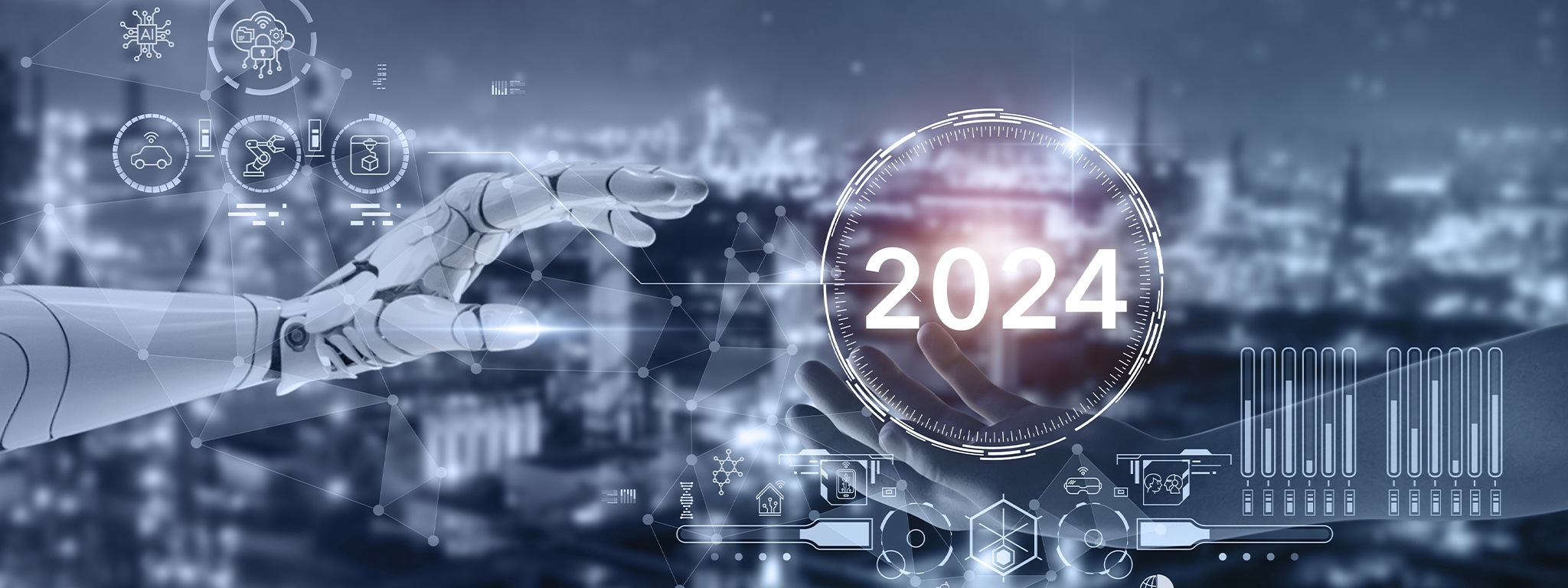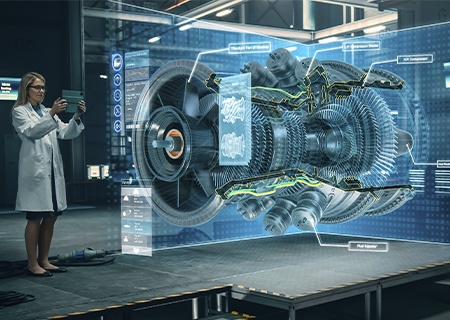Ask an Expert
Planning the right solution requires an understanding of your project and system requirements. Let Kingston's experts guide you.

The past year has brought momentous changes to the technology landscape. For many, 2023 was the year of Artificial Intelligence (AI) and Machine Learning, with platforms like ChatGPT and BardAI exploding in popularity. It was also the year in which companies globally started to consider the long-term viability of hybrid and remote working arrangements, dealing with questions around remote collaboration, productivity, and cybersecurity.
The many exciting developments of 2023 can make it hard to see what lies ahead for technology in 2024. Will we continue to see staggering developments in AI? Will immersive technologies make a long-lasting impact on businesses, and our daily lives? To answer these questions and many more, we spoke to our community of experts who shared their insights and predictions for technology in 2024.

Augmented Reality (AR) and Virtual Reality (VR) have already undergone many improvements and transformations since their introduction. Rob May foresees these developments continuing into 2024, stating that “immersive digital experiences will be revolutionised by advancements in AR/VR, offering more realistic, interactive environments and seamless integration with real-world elements, enhancing education, entertainment, and remote work.”
It is undeniable that the integration of AI and immersive technologies will result in better immersive experiences for users, thanks to AI’s potential for personalisation. Elena Carstoiu notes the possible commercial applications of this: “A study revealed that 58% of consumers see immersive experiences as influential in their purchase decisions. Thus, providing a personalised immersive digital experience has become increasingly important for the sales process. Harnessing the power of AI is the sole means to captivate and engage effectively.” Indeed, growing consumer expectations for personalisation mean that immersive experiences are no longer enough to generate excitement and engagement; they must also be personalised for their users.
Though immersive experiences occur in the digital space, it would be remiss to ignore the impact of innovations in the physical space. “CPUs, RAMs, GPUs, SSDs as well as networks and data buses are getting faster allowing to improve the experience of AR/VR applications users as graphics resolution and FPS keep increasing,” says Geoffrey Petit. Simon Besteman adds that the Apple Vision Pro, announced earlier this year and scheduled to release in March 2024, is just the beginning of next-gen Mixed Reality (MR) headsets: “Next gen devices like Apple's headset are aiming to have a much deeper interaction with the user. Analysing eye movement, temperature, even electrical activity of the skin.” All these added data points not only personalise the immersive experience but may also provide added dimensions beyond just sight and sound.
Providing a personalised immersive digital experience has become increasingly important for the sales process. Harnessing the power of AI is the sole means to captivate and engage effectively.Elena Carstoiu
Though much of the world has returned to the office since the COVID-19 pandemic, hybrid and remote working are still at a greater level than pre-pandemic. In turn, this has sparked debates about the benefits and drawbacks of hybrid work - and often, technology is at the core of these discussions, as an element of both risk and opportunity.
In 2024, we could start to see a greater focus on personalising and improving the employee experience for hybrid workers, creating a more inclusive and flexible work environment. According to Frank Jennings, we can expect to see “enhanced collaboration and decision-making tools using real-time data to focus on a particular employee’s workload and strengths while looking after their mental wellbeing (...) It could make employees more efficient and happier.” Kate Sukhanova looks even further when it comes to personalisation: “We’ll see more and avatars (metaverse or otherwise) in the workplace, making it more efficient.”
Of course, AI will also play a pivotal role in the future of hybrid working, particularly around task automation. “Automation and artificial intelligence technologies will continue to develop to automate repetitive tasks and improve productivity. They will be used to analyse data, make decisions, and optimise processes,” predicts Dr. Philippe Vynckier. AI tools are already being used by businesses to automate tasks, though there are still debates around exactly what kinds of work should be automated – and what the impact of this will be on human employees, who may find their jobs at risk.
But perhaps an even more important question - is hybrid work truly here to stay? Simon Besteman suggests that it is too early to tell, yet the long-term viability of hybrid work depends on the development and deployment of technology: “The resistance from both employers and workers will need to be addressed through technical solutions. The quality of the tech will determine the future of hybrid work.” On the other hand, Mike Gillespie is more optimistic about hybrid work but agrees that getting technology right can make or break an organisation’s hybrid work approach: “The current reliance on old ways of working i.e. forcing people through VPN conduits to access systems, services and information need to be reappraised.”
The future of emerging technologies, from AR and VR to the Internet of Things (IoT), relies on innovations in memory and storage. As Artificial Intelligence becomes increasingly used for a variety of industries and applications, its memory requirements will become an unavoidable challenge for organisations that want to make the most of this powerful technology. Elena Carstoiu explains, “AI and Machine Learning applications extract the information they require by processing substantial volumes of data (...) The storage infrastructure is crucial in ensuring a continuous supply of data to these GPUs to maintain uninterrupted usage.” As such, without the necessary developments in memory solutions, the full potential of AI may remain untapped.
Concurrently, global data volume has not slowed its growth - in fact, it has continued to increase year after year, predicted to approach{{Footnote.A72096}} 147 zettabytes in 2024. Memory and storage solutions will play a pivotal role in ensuring that data can be stored, used, and shared, says Ian Moyse: “With the exponential creation of data and engines demand to process it quicker, processing and storage needs and methods need to expand to support demands.”
Fortunately, we are seeing many innovations and improvements in memory and storage solutions, which will likely continue to do so in the coming years. Geoffrey Petit notes that “DDR5 and SSDs are getting faster and more efficient year over year improving the overall performance of HEDT, AI optimised servers, cloud servers.” Ultimately, it may be innovations in the memory and storage space that will drive the most exciting and significant new technologies in 2024.

Many challenges that businesses and governments faced in 2023 will continue into 2024, emphasising the need for effective and sustainable solutions.
Supply chain issues that have arisen in recent years, caused by a number of factors including global conflicts and climate change, continue to impact all industries and sectors - and the technology landscape has not been immune. Rafael Bloom notes that “global supply challenges in semiconductors are easing but still a factor.”
More broadly, the effects of global inflation and economic instability will continue to impact data centres into 2024. Simon Besteman highlights the additional pressures placed on data centres by both new technologies and new regulations: “Already now, we see the demand for AI and machine learning solutions exceed the capabilities of manufacturers of hardware and of the housing providers in the data centres. The pressure to work more sustainably and the pressure to deliver higher intensity computing are not easy to combine.”
Cybersecurity has been a leading concern for organisations in 2023 particularly due to the continued demand for hybrid and remote working, and this will certainly continue into 2024. Elena Carstoiu highlights the prevalence of cybercrime in recent years: “Studies indicate that 50% of businesses have fallen prey to a successful cyber-attack within the last 3 years. The projected cost is anticipated to surpass{{Footnote.A72097}} $10 trillion by the end of 2024.” And while technological advances – including Artificial Intelligence – can certainly help prevent and mitigate the impact of cybercrime, one of the biggest cyber challenges businesses will face in 2024 will be around talent. “Talent availability to address security, transformation and new tech will continue to outpace the demand and retaining the needed talent for small to mid-firms will be a big challenge,” predicts Ian Moyse.
Artificial intelligence has been mentioned numerous times throughout this article because of its significant developments in 2023, and the incredible versatility this has resulted in. Rob May predicts “significant strides in AI, particularly in natural language processing, predictive analytics, and ethical AI frameworks, enabling more personalised, efficient services across industries and advancing responsible AI use,” while Ian Moyse looks to AI and its role in future cybercrime: “Expect to see increased regulatory discussion around AI and news of AI breaches and business AI exposures. Increased cyber threats and exposure reports will continue, with the 1st reports of AI being used as an attack tool.”
As developments in hardware push the boundaries of computing, many people in the technology landscape are keen to explore quantum computing. “I do hope there is some room left in the budgets to invest in quantum tech. It deserves our attention,” says Simon Besteman. Philippe Vynckier adds that “quantum computing could revolutionise information processing with computing capabilities far greater than those of traditional computers.” In 2024, quantum computing could capture the same global excitement that AI has had in the past year.
Hybrid working will continue to be a hot button issue for organisations, as they continue to feel the effects of the remote work boom of 2020-2021. Rafael Bloom notes that “We moved so quickly because of COVID that we got stuff done without sometimes asking how/why, unknown risk has crept in.” While organisations may find themselves with new tech and tools to enable hybrid teams, they may also discover new pitfalls and risks they will need to address.
Finally, issues around talent will become impossible to ignore in 2024, says Elena Carstoiu: “According to a Gartner survey, 26% of CEOs identified talent shortage as the most damaging risk for their organisations{{Footnote.A72100}}. Prioritising talent attraction and retention, along with enhancing workforce productivity, is key.” And while various AI technologies may soften the impact of a talent shortage through task automation, businesses will really have to work to attract skilled individuals that will be able to tackle cybercrime, data, and any other future challenges they will be facing in 2024.
At Kingston Technology, we consider ourselves trusted advisors who are always looking ahead at emerging challenges and opportunities in technology, from innovations in AI to new cybercrime risks. Though we know organisations will be facing both new and old issues in 2024, we are confident that our expertise and solutions will help support our clients as they navigate this ever-evolving world.
#KingstonIsWithYou

Planning the right solution requires an understanding of your project and system requirements. Let Kingston's experts guide you.

For creatives that produce content for high-profile clients, encrypted storage can secure your important files and help you fulfil your security responsibilities.

IronKey Vault Privacy 80 External SSD is Kingston’s first innovative OS-independent hardware-encrypted external SSD with touch screen for data protection for clients from government to finance to healthcare to legal. With military-grade encryption, IronKey offers top data security.

Learn how to use all the features of your new Kingston IronKey Vault Privacy 50, with our walkthrough. We can help you with creating user and admin passwords, enabling Read-Only or Write-Protected modes, even features like One-Time Recovery passwords.
When you start with Kingston, choosing memory is easy.
With over 35 years of expertise, Kingston has the knowledge and resources you need to choose memory with confidence.
Simply enter the make and model number or system part number of the computer system or digital device to find the Kingston products you need.
Search by either the Kingston part number, distributor part number or manufacturer equivalent part number.